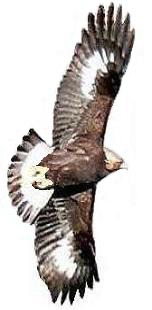Red-tailed Hawk
(Buteo jamaicensis)
Migration Timeframe:
Redtails move before the sub-adults and adults. They begin
their migration in mid-September with a peak movement in
mid-October and declining numbers into early November.
Sub-adult Redtails may move in the earlier part of the adult
migration timeframe which ultimately sees a separate peak in
early November with a steady decline to the end of the
month. Also invariably present, at any time are “local”
birds which may be inadvertently recorded as
“migrants”. In the 9 years from 1995 to 2003, November
counts represented 40% of all migrating Redtails. Migrant
Redtails can still be seen in December, albeit in declining numbers.
|
Year |
Peak Week |
Avg |
|
2002-2007 |
Oct 20-26 |
1,330 |
|
Year |
Peak Week |
Count |
|
2008 |
Oct 27-Nov 02 |
1,902 |
|
Year |
Earliest
Obs |
Count |
Year |
Latest
Obs |
Count |
|
2002-2007 |
Aug 31 2007 |
4 |
2002-2007 |
Dec 08 2007 |
27 |
|
2008 |
Aug 25 |
2 |
2008 |
Nov 22 |
26 |
Where to Watch:
Redtails migrate through the hawkwatch
area in almost any location from the cliff itself, inland to "Sharpie Alley" and
further north to the Fruit Ridge Rd. They are the most prominent
species in kettles occurring in the latter part of migration.
They will power their way into strong head winds.
High Counts:
The 2008 season was not nearly as spectacular for Redtail counts as
compared to the big flights from 2007 and no new records were set.
However, there were a few decent flight days including 940 Redtails
tallied on Nov 1st.
|
1-Year |
Count |
1-Month |
Count |
|
2007 |
11,148 |
Nov 2007 |
7,655 |
|
1-Day |
Count |
1-Hour |
Count |
|
Nov 18 2007 |
3,459 |
Nov 18 2007 |
968 |
Yearly Totals:
The 2008 yearly total was just shy of the 10-year average and well
short of the 5-Year average.
(averages are based on 1998-2007 and 2003-2007 counts).
|
Year |
Count |
Year |
Count |
Year |
Count |
|
1995 |
1,885 |
2000 |
3,181 |
2005 |
4,449 |
|
1996 |
2,767 |
2001 |
5,063 |
2006 |
6,370 |
|
1997 |
2,564 |
2002 |
2,612 |
2007 |
11,148 |
|
1998 |
2,827 |
2003 |
6,377 |
2008 |
4,159 |
|
1999 |
3,110 |
2004 |
4,811 |
2009 |
N/A |
|
10-Yr Avg |
5-Yr Avg |
|
4,993 |
6,631 |
Interesting Facts:
-
The screaming cry of the Redtail is used in many movies even
though the species may be other hawks or eagles from other
parts of the world.
-
The reddish orange colour of the tail of an adult Redtail
can be spotted at a great distance aiding in identification.
-
In 13 years, 1995 - 2007,
Redtails (57,115) represent 7.26% of all
migrants ID'd at Hawk
Cliff (786,954)
-
Female Redtails average larger than males but sexes overlap.
The larger females will defend the smaller males from
aggressive intruders in their home territories.
-
Many adults of middle and southern latitudes are sedentary,
though northern adults are migratory. All juveniles are
migratory. Those seen in
winter months in southern Ontario are likely to be
“northern” juveniles. And, many recently fledged juveniles,
in Canada and the U.S., head northward.
-
Adults birds migrating southward travel to southern Ontario,
U.S., northern Mexico, Central Americas, and islands in both
the Pacific and Atlantic oceans.
|
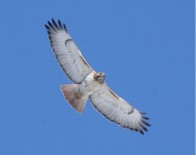 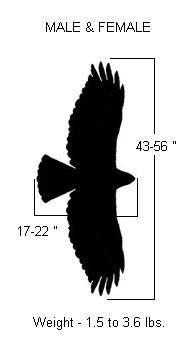
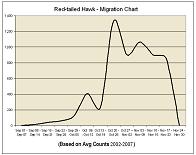
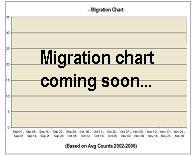
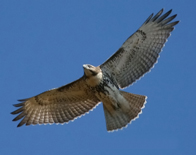
|
